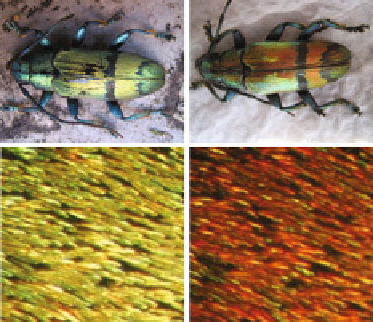Biomedical Engineering Reference
In-Depth Information
e
a
b
c
d
Fig. 8.12
Optical images of the beetle
T. isabellae
in the dry (
a
)andwet(
b
) states. The iridescent
golden color in the dry state is able to change to red in the wet state. (
c
) Close-up image of the
golden colored region of the elytra in the dry state. In the colored region the elytral surface is
densely imbricated with colored scales. (
d
)Sameas(
c
) but in the wet state. The color of the scales
becomes red. (
e
) Measured reflection spectra of the colored region of the elytra in the dry (
solid
blue line
) and fully wet (
solid red line
) under normal incidence. The spectrum for the redried elytra
is shown by a
dashed blue line
. Scale bars: (
a
)and(
b
) 10 mm; and (
c
)and(
d
) 100
m (Reproduced
from [
53
])
Polarization effects, on the other side, can be understood by the fact that
s
-and
p
-polarized light undergoes different reflection and refraction at each interface.
Specifically, there exists a brewster's angle for
p
polarization at which reflection
is zero.
In addition to cuticles, multilayers also exist in the scales on the elytra of some
beetles, e.g., the chaffer beetle
Hoplia coerulea
(Coleoptera) [
52
]. This beetle
belongs to the large family of
Scarabaeidae
. The elytra of the male beetle display
a spectacular iridescent blue-violet color. This blue-violet iridescent coloration
was found to originate from a multilayer structure in the scales on the elytra. The
structure consists of a stack of planar sheets separated by a well-organized network
of spacers. It can be approximately viewed as a multilayer. Another example was
found in the scale of the beetle
Tmesisternus isabellae
with interesting tunable
structural coloration [
53
].
The beetle
T. isabellae
belong to a large family of longhorn beetles. The colored
region of the elytra displays an iridescent golden color in the dry state, as shown
in Fig.
8.12
. With water dropped onto, the golden color can turn into red within
a few minutes. The colored region can recover the golden color by returning to
the dry state through evaporation. The colored region of the elytra is composed of
long and flat scales, responsible for the metallic golden color. In the dry state the
measured reflection spectrum of the colored region is characterized by a broad peak
positioned at about 600 nm, showing a golden color. In the wet state, however, the
reflection peak is shifted to 662 nm, showing a red color.























































































